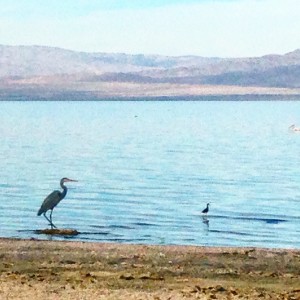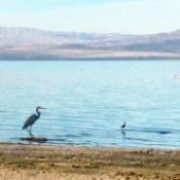
A 2015 file photo from the shores of the Salton Sea.
At a recent Salton Sea Authority Board meeting there was a very clear declaration from Board members that there is finally a reason to be optimistic about movement toward restoration at the State’s largest inland lake that stretches from Imperial to Riverside counties. Such statements of optimism came after an audience member urged caution toward becoming overly optimistic about plans when perhaps there needs to be greater focus on how successful those plans can be. Each of the Board members who responded agreed that it needs to be clearly shown through proof of concept that the projects proposed for the Sea can achieve their desired goals. However, they went on to say that after years of perceived inaction, the recent steps by Governor Edmund G. Brown’s administration and proposals under the state’s new Salton Sea Management Program should be viewed with optimism. One comment was that after so many years we deserve a chance to be optimistic.
That kind of cautious optimism should be praised. Too often, comments associated with the Sea are negative. In fact, the media in somewhat of a repetitious reporting style will focus on certain attributes of the Sea, which has been a troubled body of water for decades. Such stories spend so much time on the negatives that they hardly place any focus on what is happening at the Sea. Lost in such reports is how projects on the table represent a step forward in addressing air quality and the need for habitat in what can ultimately be a positive future of the Sea. During the Salton Sea Authority meeting, the Audubon Society was on hand to discuss their efforts at the Sea, and they, too, pointed out it would be good to see a shift in how the media reports on the Sea.
As you have probably seen in recent reports of the Governor’s signed budget, the Sea will receive $80.5 million that will allow projects to get started. That acknowledgement of the Sea on the part of Brown’s administration is an important step, and there is every reason to be optimistic that there will be additional funding for the Sea in the years to come, allowing for a phased approach to projects. That phased approach will create a scenario where proof of concept can be used to determine the success of such projects.
Some would argue that for too long they’ve heard talk of steps being taken at the Sea but nothing has actually happened. Certainly the $9 billion restoration project proposed by the State in 2007 slowed progress down. Others would argue the Salton Sea is not a State priority compared to other issues like the drought and the twin tunnels proposal for the State Water Project. Such arguments are understandable, but it is also fair to look at the steps being taken now and the recent State funding to the Sea and acknowledge that a shift has started to occur. There are a great many stakeholders following this issue and despite differences among some of the parties, everyone is united in lobbying for the State to maintain this new push in support of the Sea.
So yes, as the Salton Sea Authority Board pointed out, it is time to feel a sense of optimism. We can do so without letting down our guard. We can do so while continuing to push the State to achieve its restoration obligations in a manner that makes sense and is fundable.
